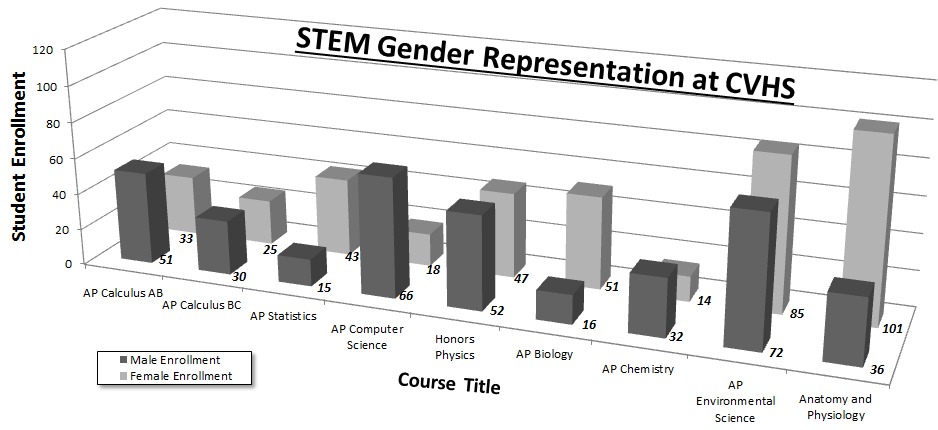The STEM of gender inequality

Stepping into an AP class would be difficult for anyone. The prospect of college level material is enough to instigate fear from miles away, but the number of student enrolling in these classes have exponentially grown, as more individuals challenge themselves at the highest level.
But as some classes have experience an increase of interest, many advanced math and science classes still face the ongoing issue of closing gender gaps, particularly in getting more females attracted to more difficult subjects. Walking into the average CVHS AP Computer Science classroom, one may only find 9 girls among their 34 male counterparts.
It is constantly told that the future lies in technology. With society becoming increasingly reliant on the innovations of the Silicon Valley, the demand for employees in the fields of science, technology, engineering, and math (STEM) have skyrocketed.
Yet, despite the promises of increased growth, there has been close to no change of female employment in these fields since 2000. While women make up nearly half of the United States workforce, they represent less than a quarter of those employed in STEM fields.
As a working woman in the engineering field, chemistry teacher Deborah Yager had faced this issue on a daily basis. Yager was the first female recipient of a Bioengineering PhD from the University of California, San Diego, and recalls the difficulties she faced breaking the gender barrier.
“Women still struggle socially in an environment with all men, who are unable to relate,” said Yager. “It just becomes very lonely.”
Within the fields of math and science, there exists an even larger gender disparity when examining specific occupations. According to a report by the American Association of University Women, women have typically dominated the “soft science” of biology, but only make up 27.5 percent of computer scientists, 13.1 percent of chemical engineers, and 6.7 percent of mechanical engineers.
“There are more women entering STEM, that are successful in both industrial and academia, but it’s just hard in general,” said Yager, ”especially in math, computer science, and physics.”
Math teacher Dianna Fletcher shares similar experiences in her own work.
“When I was working in physics, it was hard being female,” said Fletcher. “They didn’t take me or my work very seriously.”
As a computer science major at University of California, Berkeley, Fletcher’s daughter faced even more hardships in her college years.
“For her, it was pretty awful being female,” Fletcher said. “Professors ridiculed females, and a lot of the guys were doing the same.”
These extreme gender stereotypes in STEM subjects takes root many years prior to entering the professional world, and is reflected in the student enrollment of various math and science classes. At CVHS, males have continued to dominate the math and science departments, outnumbering females in nearly every STEM honors or AP course.
“There are more boys in these advanced classes just because fewer girls chose to take them,” said junior Will Fong. “As each individual person decided on their classes, it ended up with more guys choosing them than girls.”
This trend continues nationwide, as shown through demographic information of 2013 AP testing, released by the College Board. For every one girl, there were about 4.5 more boys who tested for Computer Science, 3.5 for Physics C: Electricity & Magnetism, 2 for Physics B, and 1.5 in Calculus BC.
According to demographics released at the start of the school year, CVHS sees a similar gap between male and female enrollment in STEM subjects. Males outnumber females 1.55:1 in AP Calculus AB, 1.2:1 in AP Calculus BC, 2.29:1 in AP Chemistry, and 3.67:1 in AP Computer Science.
In other words, some AP math and science classes have almost four boys to every girl.
Sophomore Nancy Nguyen has experienced this gender divide firsthand, being one of the only girls in her AP Calculus AB class.
“I think that there should be more girls that enroll in these AP math and science classes,” said Nguyen. “If more girls go into these subjects, we would not be seen as inferior.”
A large factor in this great disparity is gender roles that have implemented from childhood. The humanities (English, literature, social sciences) are considered to be feminine, while STEM subjects (chemistry, physics, calculus) are geared towards boys.
“There’s also that stereotype that ‘being dumb is cute,’ which might discourage girls from enrolling in high level math or science classes,” said sophomore Brandon Yap.
However, females at CVHS have had an increasing presence in certain STEM subjects, starting with those that have been deemed the “easy APs.” Girls make up a majority of students enrolled in AP Statistics, AP Biology, and AP Environmental science.
As one of the world’s leader in technology, the United States will continue to hold much influence in the scientific world. Yet, little advancement can be made with the exclusion of an entire gender.
As Fletcher said, “The system itself won’t really change until women push. Men won’t be willing to give up their power.”

